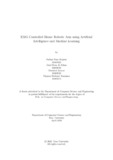| dc.contributor.advisor | Islam, Md. Motaharul | |
| dc.contributor.author | Rupom, Farhan Fuad | |
| dc.contributor.author | Johan, Gazi Musa Al | |
| dc.contributor.author | Jannat, Shafaitul | |
| dc.contributor.author | Tamanna, Farjana Ferdousi | |
| dc.date.accessioned | 2021-07-03T15:24:27Z | |
| dc.date.available | 2021-07-03T15:24:27Z | |
| dc.date.copyright | 2020 | |
| dc.date.issued | 2020-04 | |
| dc.identifier.other | ID 16301122 | |
| dc.identifier.other | ID 16101050 | |
| dc.identifier.other | ID 16301050 | |
| dc.identifier.other | ID 16301173 | |
| dc.identifier.uri | http://hdl.handle.net/10361/14728 | |
| dc.description | This thesis is submitted in partial fulfillment of the requirements for the degree of Bachelor of Science in Computer Science and Engineering, 2020. | en_US |
| dc.description | Cataloged from PDF version of thesis. | |
| dc.description | Includes bibliographical references (pages 45-47). | |
| dc.description.abstract | Electromyography is a unique approach for recording and analyzing the electrical
activity generated by muscles, and a Myo-electric controlled prosthetic limb is an
outwardly controlled artificial limb which is controlled by the electrical signals instinctively
produced by the muscle system itself. Artificial Intelligence and Machine
learning is very powerful in every technological field along with biomedical field. The
purpose of this work is to utilize the power of Machine learning and Deep learning for
predicting and recognizing hand gestures for prosthetic hand from collecting data of
muscle activities. Although this technology already exists in the technological world
but those are very costly and not available in developing countries. So, designing
a cost effective prosthetic hand with the maximize accuracy is the major focus and
objective of this work. We have also used a data set recorded by MyoWare Muscle
Sensor which represents uninterrupted readings from 8 sensors. We have used Deep
learning with the data set for predicting the following gestures which are handopen,
hand-close, spherical-grip, and fine-pinch. Then we used some algorithms of
Machine Learning which are K-nearest Neighbor (KNN), Support Vector Machine
(SVM), and also the combination of KNN and SVM both for feature classification on
data recorded with the 8-electrode surface EMG (sEMG) MyoWare Muscle Sensor.
Using the combination of SVM and KNN We have accomplished a real time test accuracy
of 96.33 percent at classifying the four gestures of our prosthetic hand. This
paper also represents 3D modeling of the robotic hand and its control system using
Autodesk 3D’s Max software, EMG MyoWare Muscle Sensor, Machine Learning and
Deep Learning. | en_US |
| dc.description.statementofresponsibility | Farhan Fuad Rupom | |
| dc.description.statementofresponsibility | Gazi Musa Al Johan | |
| dc.description.statementofresponsibility | Shafaitul Jannat | |
| dc.description.statementofresponsibility | Farjana Ferdousi Tamanna | |
| dc.format.extent | 47 pages | |
| dc.language.iso | en | en_US |
| dc.publisher | Brac University | en_US |
| dc.rights | Brac University theses are protected by copyright. They may be viewed from this source for any purpose, but reproduction or distribution in any format is prohibited without written permission. | |
| dc.subject | Electromyography | en_US |
| dc.subject | Hand gestures | en_US |
| dc.subject | K-nearest Neighbor (KNN) | en_US |
| dc.subject | Support Vector Machine (SVM) | en_US |
| dc.subject | EMG MyoWare Muscle Sensor | en_US |
| dc.subject | Autodesk 3D Max software | en_US |
| dc.subject | Prosthetic | en_US |
| dc.subject.lcsh | Biomaterials. | |
| dc.subject.lcsh | Artificial intelligence. | |
| dc.subject.lcsh | Machine learning. | |
| dc.title | EMG controlled bionic robotic arm using artificial intelligence and machine learning | en_US |
| dc.type | Thesis | en_US |
| dc.contributor.department | Department of Computer Science and Engineering, Brac University | |
| dc.description.degree | B. Computer Science | |

